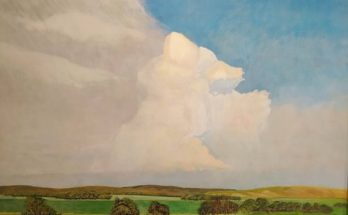By Francisco Peyret
Franco Aceves Humana
Regardless of the technique he uses—whether oil, watercolor, or egg tempera—Franco Aceves Humana has limited his palette to blue, red, yellow, black, and white. These he uses in a pure state, without mixing. He applies them in layers of greater or lesser transparency, adding to them to achieve desired colors and tones. According to him, this is a way of making the work more elementary. The two most recent series, Fauna Afín al Progreso and Naturalezas Muertas, which are being exhibited, share this common trait in the technique he uses.
Franco’s work has always jumped from one side to another, but this series addresses his recurring constant—humor and irony. In the recent series Fauna Afín al Progreso, he paints situations that remind us of how dangerous we are as a species. He expresses this sharp criticism using irony as a weapon. His works can make us laugh, but they also point a finger at our irresponsibility. They also function as fables, giving voice and opinion to the affected fauna, showing how it is harmed, and praising the victims. These paintings become visual representations of the morals (or lack, thereof) that apply to our societies.
Still life
This series shows two recurring themes in Franco’s works: first, a perverse taste, as he himself calls it, for pretending that there is disorder, that what is observed in his works are products of chance. This, he admits, is practically impossible, because the brain seeks order. Second, the obsession to create depth without perspective, of objects suspended further or closer, as if floating, so the viewer feels that there are three dimensions within the two-dimensional work. To emphasize this effect, he sometimes uses balls of solid colors behind or in front of natural objects, without the size implying greater proximity. In this way he evokes the supposed chance that he wants to represent.
Javier Areán with Damnatio Memoriae
In ancient Rome it was common for certain individuals, considered enemies of the state, to be punished by having all memories about them erased after their death. It was called the Damnatio Memoriae or «condemnation of memory» and was decreed by the Roman Senate. It was meant to eliminate or erase images, monuments, and inscriptions that recalled the condemned. It could go as far as banning the use of their names in public. In recent times, Damnatio Memoriae has been used by numerous modern authoritarian systems like Stalinist Russia, and Mao Tse-Tung’s China as an exercise of state power. Another example was the destruction of historical images by the Islamic State in an attempt to erase people’s identity, history and their past.
For this exhibition, Javier Areán has made a series of paintings based on photographs found in public archives. These photos show people detained during different historical and political conflicts, whose identities have been erased. In the large-format paintings, the student movement of 1968 in Mexico stands out. The identity of the detainees was censored during the administration of President Enrique Peña Nieto, by the General Archive of the Nation.
Javier Areán (Mexico City, 1969) is an artist who works predominantly in painting and drawing. He also occasionally experiments with alternative media such as video, installation, and performance. His work is based on the study of memory, and its relationship with artistic creation, specifically through the concept of post-memory.
Antonio Chaurand with Ente
We live haunted by a ghost, an entity. We cannot see it but it haunts us despite being abstract and intangible; we cannot get rid of it because it is part of us. It inhabits our spaces, it changes, it grows, we feed it day by day. It lives on our fears, doubts, and grudges; it gets fat on our lies, our envy, our anger, and our complexes. All the emotions and feelings that we keep quiet about. Its growth seems haphazard; it is irregular and unpredictable. It constantly develops new members that subsequently mutate. It is a beast, a chimera and also a machine. Sometimes, when we are immersed in sleep, we get a glimpse of it. But always with masks, always halfway. This ghost flirts and hides, as if mocking us, wanting to remind us that it is there, and that it will be there always.
The exhibition will take place on Sunday, March 12, from 12 to 4pm, at Yam Gallery, Ancha de San Antonio 20.




